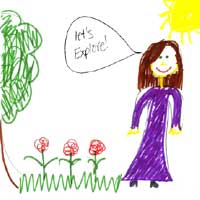Introduction
 Project Nexus, an NSF supported research program at the University of Maryland, has developed and tested a science teacher professional development model that prepares, supports, and sustains upper elementary and middle level specialist science teachers. Our research team studied the influence of an internship in informal science education as part of a teacher preparation program, continuing into the first year of teaching. A major research goal was investigating how the science teaching identity of the teacher interns/teachers changed over time.
Project Nexus, an NSF supported research program at the University of Maryland, has developed and tested a science teacher professional development model that prepares, supports, and sustains upper elementary and middle level specialist science teachers. Our research team studied the influence of an internship in informal science education as part of a teacher preparation program, continuing into the first year of teaching. A major research goal was investigating how the science teaching identity of the teacher interns/teachers changed over time.

|
| Source: Wikipedia |
In our study, drawings were an important source of evidence used to measure changes in participants' science teaching identity. We recognize that drawings have a controversial history in science education research. Both children and adults have drawn their conception of scientists and their science education experiences with pleasure (Thomas, Pedersen & Finson, 2001; Schibeci & Sorensen, 1983; White & Gunstone, 1992). These researchers have found drawings a good initial point for reflection and discussion, eliciting information that may not be accessible in other data sources. The Draw a Scientist Test (DAST) has raised concerns about the consistency of the administration of the prompt (Symington and Spurling, 1990) as well as the validity of the data, considering interpretive issues, such as the researcher's "scientist" concept compared to that of the illustrator's (Schibeci & Soresen, 1983), the need for accompanying narrative to clarify intent (Thomas, Pedersen & Finson, 2001) and the social construction of a "scientist" which the illustrator brings to the task (Schibeci, 1986). Finson cautioned that the Draw-A-Science Teacher Teaching Checklist was an evolving tool which could yield differing interpretations as it changed (Finson, 2001).
With this prior research in mind, we coupled our interpretation of science teaching identity development evidenced in these drawings with other data sources such as interviews and participant writing. We also used repeated measures over three years with our sample. This allowed for the participants' momentary thinking to be analyzed over time for continuing and changing characteristics. We developed a rating scale that was keyed to the latest documents published by the National Academy of Science to analyze the drawings through expert goal statements beyond our research group. We worked rigorously on inter-rater reliability, refining our rubric as multiple interpretations arose.
Our research involved a collaborative effort between a university teacher education program and informal science education program Hands On Science Outreach, Inc. (HOSO), an afterschool enrichment program within the realm of informal science education (ISE). We used teaching identity development theory to investigate the effects of our project in science teaching education. During the project, teacher candidates could choose an internship for an eight week session of HOSO. Participants were asked to draw pre- and post-internship, pre- and post-methods class, and for case studies, before and after their first year of teaching. We asked them to respond to two prompts:
- Draw Yourself Teaching Science
- Draw Your Students Learning Science
These prompts enabled us to gain insights into the ways that teacher candidates thought about the teaching and learning relationship at different points during their university program and first teaching year. The drawings, supported by interview and written text, were analyzed with a rubric developed for the study, The rubric was based on the science learning goals as published in Taking Science to School (NRC, 2007) and Learning Science in Informal Environments (NRC, 2009), both published by the National Academy of Science.
The rubric, along with examples for scoring, is provided on this site. In addition, a detailed description of the use of drawings to study teacher identity can be found in Professional Identity Development of Teacher Candidates Participating in an Informal Science Education Internship: A focus on drawings as evidence (full version available).

